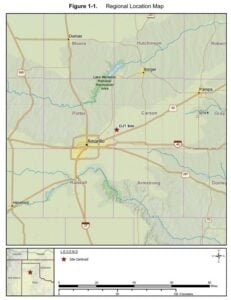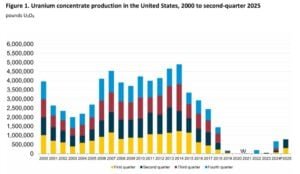Disseminated on behalf of Uranium Royalty Corp.
The United States is entering a new phase in clean energy. It now combines artificial intelligence (AI), advanced data centers, and nuclear power in one system. At the center of this shift is Project Matador, aka Donald J. Trump Generating Plant, a plan to build an 11-gigawatt (GW) energy and data campus in Texas.
The project aims to become one of the largest clean energy and computing developments in the world. Led by Fermi America LLC, it could change how data centers get their power. Its mix of nuclear, solar, natural gas, and battery storage is designed to provide steady, low-carbon energy for the growing AI and chip industries.
The Vision Behind Project Matador
Project Matador is one of the most ambitious U.S. energy projects in decades. It will cover about 5,855 acres in Carson County, Texas, under a 99-year lease with Texas Tech University.

The site will host four Westinghouse AP1000 nuclear reactors, along with solar panels, batteries, and natural gas plants. Together, these systems will generate up to 11 GW of reliable power for large data centers and chip factories built on the same campus.
Fermi America plans to begin construction in 2026. The first nuclear reactor could start running by 2031, with all 4 completed by 2038. The total cost could reach $70–90 billion.
The nuclear reactors will use the proven AP1000 design, known for its strong safety features. The site near Amarillo was chosen for its stable geology, existing infrastructure, and strong power connections. The area also sits next to a long-standing federal facility, which helps with environmental and safety approvals.
Building the AI Energy Campus of the Future
Project Matador is more than a power plant – it’s a purpose-built, vertically integrated energy campus designed to power America’s next wave of digital industries: hyperscale AI data centers and advanced semiconductor manufacturing. By combining four Westinghouse AP1000 nuclear reactors, large-scale battery storage, combined-cycle natural gas, and on-site solar, Matador delivers round-the-clock, zero-carbon electricity within a single, secured perimeter.
![]()
This model solves major challenges for high-tech facilities. AI systems and chip fabs demand continuous, multi-gigawatt power – often beyond what traditional grids can supply. Matador’s behind-the-meter setup keeps energy onsite, delivering reliable power directly to data centers and manufacturing plants. Its nuclear generators supply up to 4.4 GW of steady baseload, while batteries provide backup and frequency control, guarding sensitive compute clusters from outages. Natural gas and solar add further resilience, keeping operations stable even during grid stress.
For data centers, this means 24/7 uptime and low-carbon power for demanding AI, cloud, and security workloads. Hyperscale operations can use over 3 GW each, so every minute of reliable energy protects millions in value and supports technology leadership. Google, Meta, and Nvidia benefit directly from Matador’s self-sustaining grid, bypassing public utility risks.
Semiconductor manufacturing is also strengthened. Chip fabs are North America’s most power-sensitive assets – a single disruption can halt modernization and risk supply chains. By hosting robust, secure energy onsite, Matador drives U.S. onshoring under the CHIPS Act, boosting sector growth and jobs.
Alongside these benefits, the campus reduces grid strain, lowers emissions, and creates thousands of jobs. Fermi America’s initiative sets a new standard for strategic nuclear and hybrid energy infrastructure, anchoring America’s future in clean, resilient, and tech-driven power. With 11 GW of clean electricity, Matador reduces foreign dependence and supports federal goals for secure compute and chip operations – driving over 50,000 jobs and future-proof growth. Its integrated model establishes a global benchmark for sustainable, strategic industrial power.
Building Global Partnerships: South Korea’s Role in the U.S. Nuclear Comeback
The company signed important deals in South Korea for nuclear technology and component production. It signed a FEED (front-end engineering design) deal with Hyundai Engineering & Construction. This deal will kick off the engineering of four AP1000 reactors.
Also, it reached a deal with Doosan Enerbility. This agreement secures long-lead components, such as reactor pressure vessels and steam generators. These moves lock in key suppliers and help protect the project’s timeline and cost estimates.
Toby Neugebauer, Co-founder & CEO of Fermi America, stated:
“Doosan Enerbility and Hyundai E&C have been waiting for an American company to stop power pointing about nuclear and start building it. Their firm commitment to Fermi America positions us for action, leveraging their track record of success to build clean, new nuclear power at the velocity and scale the President demands and the U.S. requires.”
Fermi notes that it was the first company to file a combined operating license that the NRC accepted for review in September 2025. The company thanked Texas leaders. It also highlighted the state’s new $350 million funding for the Texas Advanced Nuclear Energy Office (TANEO) to support the build.
These partnerships will boost the AP1000 reactor supply chain. They will also strengthen connections between the U.S. and Korea in advanced energy development.
The AP1000, built by Westinghouse Electric Company, is one of the world’s safest and most efficient nuclear reactor designs. It uses passive safety systems that can cool the reactor without human action or external power. This makes it ideal for modern, high-security facilities like Project Matador.
Fermi America will fund construction through a mix of private equity, REITs, and federal loan guarantees. This method shares financial risk. It also makes sure the project follows strict safety and environmental rules.
Nuclear Power’s Return and How UROY Stands to Gain From It
Projects like Matador show that nuclear power is making a comeback in the U.S. After years of slow progress, nuclear energy is now viewed as essential for clean power and energy security. The rise of AI, cloud computing, and electric vehicles has sharply increased demand for dependable electricity.
For investors, this creates new opportunities in uranium and nuclear development. Uranium Royalty Corp (UROY) is one company well-positioned to benefit. Based in Canada, UROY owns royalties and streams linked to uranium mines around the world. This means it earns a share of revenue from uranium production without operating the mines itself.
UROY also holds physical uranium reserves, giving it direct exposure to fuel price increases. As new reactors like those at Matador move closer to construction, demand for uranium will rise. UROY’s business model allows investors to gain from this trend without the high costs or risks of running a mining company.
UROY benefits when uranium prices climb or when more nuclear power plants sign fuel contracts. The U.S. currently produces less than 10% of the uranium it needs and depends heavily on imports. To fix this, the government is supporting efforts to rebuild the domestic uranium supply chain.

As new U.S. nuclear projects start – including Matador, TerraPower’s Natrium reactor, and Oklo’s advanced fission systems – the need for uranium fuel will grow. That means higher demand for UROY’s royalty partners and assets.
![]()
Even though UROY is not tied to a single project, its portfolio rises in value as the global nuclear market expands. If the U.S. adds dozens of gigawatts of nuclear capacity by 2040, UROY could see major growth in both royalty revenue and asset value.
The Bigger Picture: Clean Power for the Digital Era
Project Matador shows how the energy transition and the digital economy are coming together. AI and chip manufacturing need clean, steady power — and nuclear energy can deliver it.
For the U.S., this kind of project also supports national security, ensuring that data and computing systems run on domestic, reliable energy.
For investors, companies like UROY offer a simple way to invest in the nuclear revival. They benefit as more projects move forward and uranium demand increases.
The next generation of clean energy will go beyond solar and wind. It will combine nuclear stability, renewable flexibility, and digital intelligence, all working together to power the AI age.
Disclosure: Owners, members, directors, and employees of carboncredits.com have/may have stock or option positions in any of the companies mentioned: None.
Carboncredits.com receives compensation for this publication and has a business relationship with any company whose stock(s) is/are mentioned in this article.
Additional disclosure: This communication serves the sole purpose of adding value to the research process and is for information only. Please do your own due diligence. Every investment in securities mentioned in publications of carboncredits.com involves risks that could lead to a total loss of the invested capital.
Please read our Full RISKS and DISCLOSURE here.
The post Project Matador: America’s $90B Nuclear Power Solution for AI, Semiconductors, and Data Centers appeared first on Carbon Credits.














